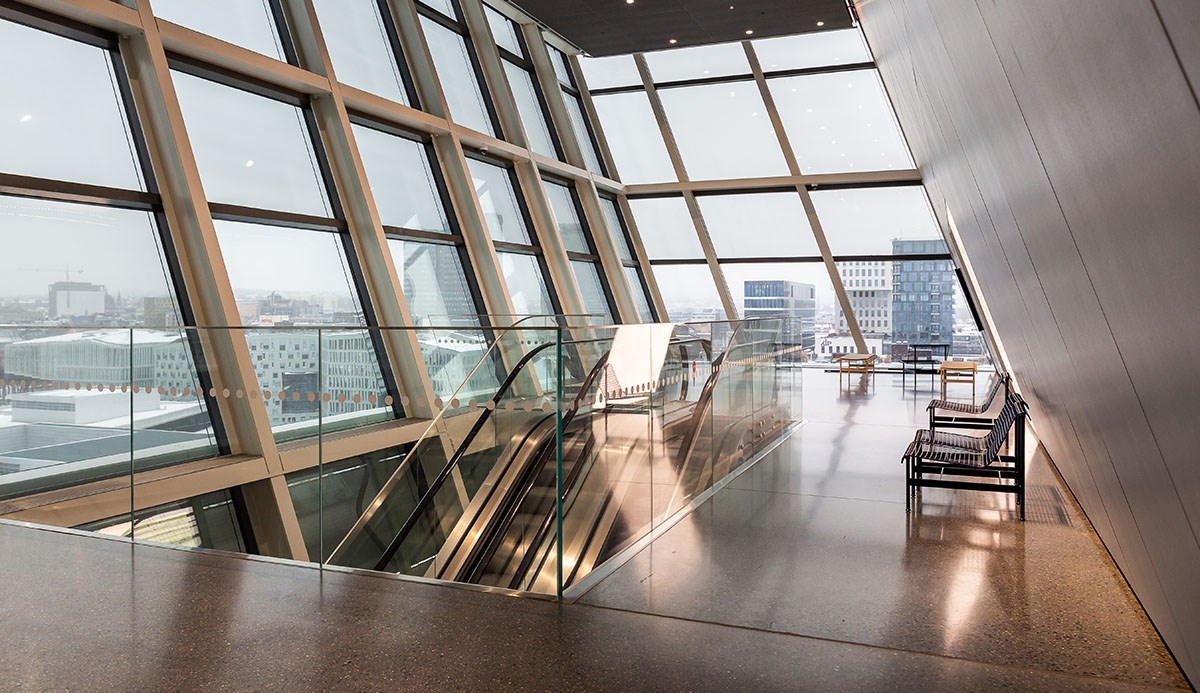The Munch Museum: Built for the future
With elevators that store their own energy, a grass roof and a cooling system based on seawater, the new Munch Museum has become a futuristic home for some of Norway’s artistic treasures in the centre of Oslo.
In central Oslo, in an entirely new district that is shooting up along the waterfront, a new building that has already become a landmark is to be found stretching towards the clouds. And, behind the glass and aluminium, the public will soon be allowed to explore the building’s heights and to experience both Edvard Munch’s world-renowned art and the views the building affords of Norway’s capital. The architects’ desire was that the public would raise their eyes to contemplate not only Munch’s art but also Norway’s growing capital city.
The result of the architects’ vision is a 60m-tall vertical museum that has a façade clad in translucent, perforated aluminium panels and a defining ‘bend’ to its top section. The architects describe the ‘bend’ as the building ‘bowing respectfully towards the city’ – which is the city in which Munch grew up.
However, the art museum is much more than a new home for the artistic treasures produced by Munch; the museum has also been built for the future.
The elevators store their own energy, the building has a grass roof and the air in the exhibition spaces is recycled to reduce energy consumption. The façade has also been designed so it offers protection from the sun, thus reducing the need to cool the building during the summer. And the system used to cool the building is based on seawater. Turning to the materials used for the building, ambitious requirements were set for the proportion of recycled steel and aluminium that had to be used, while the concrete was produced using a modern production technique that generates less greenhouse gas emissions.
Furthermore, the building has been sited right by a public transport hub and does not have any parking spaces. In this way the City of Oslo ensures that the building will actually be used in a more environmentally friendly way. It will be a museum that visitors reach either by bike, on foot or by public transport.
“The aim was to reduce the building’s greenhouse gas emissions by more than 50%, and we managed to achieve this”, explains Karianne Tvedt from Advansia, who was responsible for the environmental dimension of the building’s project management.

Apply for a green loan
We offer green loans with a lower interest rate for climate and environmentally friendly projects.
“Think about the climate right from the start”
“Building an environmentally friendly building is a question of starting early. You need to set clear requirements right from the start of the planning phase, and environmental considerations need to be an integral part of the entire process. This approach also often saves money. If you only start to focus on environmental considerations once your project is underway, you will often have to make expensive changes”, explains Karianne Tvedt.
She thinks that this approach was an important reason for their success in achieving the climate objectives for the Munch Museum.
Munch is popular
In his will Edvard Munch left Oslo 1,100 paintings, 15,500 prints, 4,700 drawings and six sculptures, as well as all his print plates. From Oslo’s perspective, Munch is a draw for both international and Norwegian tourists. When the new Munch Museum opens to the public in the summer of 2021, the public will be able to view a larger proportion of the collection than there was space for in the old museum – More Edvard Munch than ever before – as the Museum itself describes it.
Nowadays, you no longer need to travel out of Oslo to have a swim in the sea – so if you remember to bring your swimming towel with you when visiting the Munch Museum, you can combine seeing some art with a dip in the Sørenga seawater bathing area with its jetties and sauna – all of which is a short stroll away from the main entrance. “Nature is the infinite realm from which art takes its nourishment”, as Edvard Munch himself wrote.
Key figures
Outstanding lending:
NOK 2 billion*
Total cost:
NOK 2.59 billion
Estimated energy savings:
988,956 (kWh/year)**
Equivalent in avoided greenhouse gas emissions:
312 (tonnes CO2e/year)**
